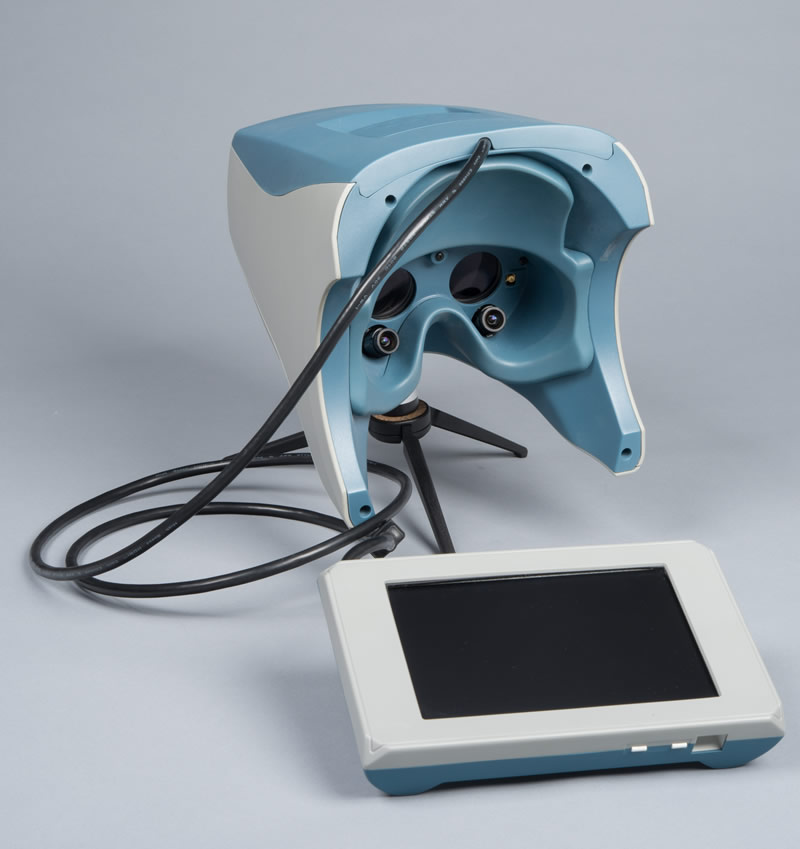Concussion Diagnostic Tool Added to National Medical Collection
By Lauren Bigge
NMHM Public Affairs Coordinator
Virtual-reality goggles that test for subtle attention problems are part of a new tool available for diagnosing and treating warfighters with potential brain injuries. A prototype artifact of this technology, called EYE-SYNC, was recently added to the National Museum of Health and Medicine’s collections, which already includes a brain hematoma detector known as Infrascanner Model 2000.
The EYE-TRAC (EYE-Tracking Rapid Attention Computation) device, according to its developers, was designed to be rugged enough for use in combat zones, with software that can distinguish concussion symptoms from post-traumatic stress disorder and fatigue. The eye-tracking device, later called EYE-SYNC, was approved by the Food and Drug Administration (FDA) in 2016.
As the user wears the EYE-SYNC goggles and watches a dot travel in a circle on a screen for 15 seconds, two high-speed infrared cameras are recording, viewing, and analyzing eye movements. The resulting data can be used for treating concussions or other mild traumatic brain injuries (mTBI), because eye movement and synchronization are sometimes disrupted, resulting in "double vision."
Lt. Col. Chessley Atchison, program manager of U.S. Army Medical Research and Materiel Command’s (USAMRMC) Technology Enabled Capabilities Demonstration at Fort Detrick, Md., transferred the EYE-SYNC to NMHM in November 2014. NMHM featured the artifact during "Brain Awareness Week" at the museum in 2015 and 2016, and it was showcased at the 2014 annual meeting of AMSUS–The Society of Federal Health Professionals.
Alan Hawk, who manages Historical Collections at the museum, sought the addition of an EYE-SYNC to the collection because it is presently focused on topics such as combat casualty care, diagnostic technology, and blast injury. NMHM is a Department of Defense museum; the DoD has been increasingly concerned about service members sustaining TBIs since the early days of the Iraq and Afghanistan wars. Other related artifacts in the collection include neurological hammers first developed around the turn of the 20th century to elicit muscle stretch reflexes; psychological diagnostic tests, such as the Revised Stanford-Binet Scale and Wechsler-Bellevue Intelligence Scale; and a 1960s-era Grass Model 6 Electroencephalograph.
"Our understanding of traumatic brain injury is directly related to the concentration of patients sustaining blast injuries from improvised explosive devices during the wars in Iraq and Afghanistan," Hawk said. "TBI was not really a clear concept before the wars. It is important to preserve devices like the EYE-SYNC and the Infrascanner to characterize and diagnose the condition as understanding of it evolves."
Col. Todd Rasmussen, now Associate Dean for Research at Uniformed Services University, was the director of the USAMRMC’s Combat Casualty Care Research Program (CCCRP) at Fort Detrick when he said at an FDA hearing last year that war has fostered the understanding of TBI. In 2017, CCCRP reports that incidents of TBI among active-duty military personnel have more than doubled since 2000, with more than 22,000 cases alone in 2015, the last year for which complete data is available.
The CCCRP confirmed in June 2017 that the work with the EYE-SYNC is progressing. CCCRP Neurotrauma and Traumatic Brain Injury Portfolio Manager Tammy Crowder noted the importance of being able to diagnose all head injury levels as soon as possible on the battlefield.
"It’s important in a forward environment to be able to diagnose concussion," Dr. Crowder said. "It’s important to nail it down as soon as it’s feasible, as soon as it’s practical; because if they’re not at their best then they could lose their whole squad or their platoon … they have to be making good judgement."
Click any photo to view larger version




